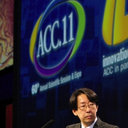Impact of acarbose on carotid intima-media thickness in patients with newly diagnosed impaired glucose tolerance or mild type 2 diabetes mellitus: A one-year, prospective, randomized, open-label, parallel-group study in Japanese adults with established coronary artery disease.
Anahtar kelimeler
Öz
OBJECTIVE
This study examined the effect of acarbose therapy on carotid intima-media thickness (IMT) in patients with established coronary artery disease (CAD) who had been newly diagnosed with impaired glucose tolerance (IGT) or mild type 2 diabetes mellitus (T2DM).
METHODS
This was a 1-year, prospective, randomized, open-label, parallel-group study in patients with established CAD (≥50% stenosis on quantitative coronary angiography) who were newly diagnosed with IGT or mild T2DM. IGT was defined as 2-hour glucose concentrations of 140 to 199 mg/dL on the 75-g oral glucose tolerance test (OGTT). Mild T2DM was defined as a fasting plasma glucose concentration <126 mg/dL, 2-hour plasma glucose concentration on OGTT >200 mg/dL, and glycosylated hemoglobin (HbA(1c)) <6.5%. On the day after undergoing coronary angiography, patients were randomly allocated to receive either acarbose 150 mg/d or control (no treatment). Carotid IMT was measured by ultrasonography at baseline and at 12 months of follow-up. The changes in glucose profiles (75-g OGTT), HbA(1c), and lipid profiles were also compared between baseline and follow-up. At visits every 2 months, data on adverse events, drug adherence, and changes in medication were collected. Adverse events were recorded based on spontaneous reports and questioning by the investigator. Clinical follow-up data on outcomes of interest were obtained from patients' hospital charts or from telephone interviews; these outcomes were the incidence of mortality, nonfatal myocardial infarction, repeat percutaneous coronary intervention for a treated coronary artery, and stroke.
RESULTS
Ninety Japanese patients were enrolled in the study (45 in each group). Two patients in the acarbose group discontinued therapy due to drug-related diarrhea, and 1 patient in each group was discontinued because of a newly diagnosed malignancy. Three patients in the control group were discontinued because they initiated treatment with fibrates, and 2 patients in the control group were lost to follow-up. Thus, complete baseline and follow-up data were available for 42 patients in the acarbose group and 39 in the control group. These 81 patients were predominantly male (74 [91.4%]), with a mean (SD) age of 66.3 (9.0) years, mean body weight of 65.9 (10.5) kg, and mean HbA(1c) of 5.57% (0.38%). Baseline characteristics appeared to be comparable between the 2 groups. In the acarbose group, IMT increased from a mean of 1.28 (0.53) mm at baseline to 1.30 (0.52) mm at 12-month follow-up (mean change, 0.02 [0.29] mm; P = NS), whereas in the control group, it increased from a mean of 1.15 (0.37) mm to 1.32 (0.46) mm (mean change, 0.17 [0.25] mm; P < 0.001 ). The difference between groups was statistically significant (P = 0.01). In addition, the acarbose group had significant reductions from baseline in 2-hour glucose concentrations on the 75-g OGTT (mean change, -24.8 [45.2] mg/dL; P = 0.001), fasting total cholesterol (mean change, -11.26 [26.1] mg/dL; P = 0.009), and fasting triglyceride concentrations (mean change, -30.4 [62.7] mg/dL; P = 0.003), whereas the corresponding changes were not significant in the control group (mean change, -8.5 [39.4], -6.22 [26.7], and -1.05 [74.2] mg/dL, respectively). Cardiovascular events requiring hospitalization occurred in 4 patients (9.5%) in the acarbose group and 4 patients (10.3%) in the control group. No deaths, nonfatal myocardial infarctions, or strokes occurred in either group over the follow-up period.
CONCLUSIONS
In this small, open-label study in patients with established CAD who were newly diagnosed with IGT or mild T2DM, 12 months of treatment with acarbose was associated with a beneficial effect in terms of preventing the progression of carotid IMT compared with control, although it was not associated with a significant decrease in IMT from baseline. UMIN (University Hospital Medical Information Network) Clinical Trials Registry identifier: UMIN000000544.


